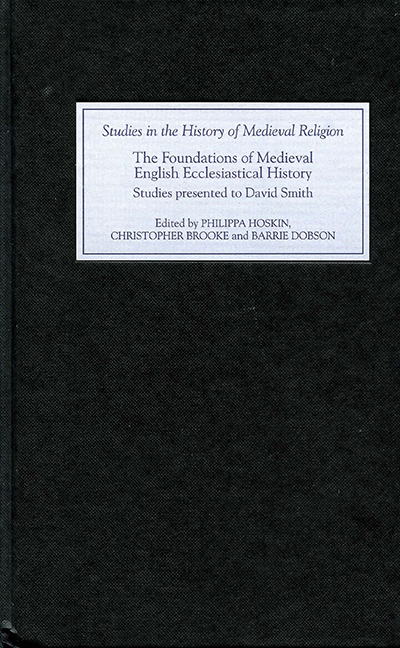Book contents
- Frontmatter
- Contents
- List of Contributors
- Acknowledgements
- Abbreviations
- Miscellaneous Frontmatter
- David Smith: the Scholar
- ‘The archivist is not and ought not to be a historian.’ David Smith and the Borthwick Institute
- Why Forge Episcopal Acta? Preliminary Observations on the Forged Charters in the English Episcopal Acta Series
- Pastors and Masters: the Beneficed Clergy of North-East Lincolnshire, 1290–1340
- The Convent and the Community: Cause Papers as a Source for Monastic History
- Patriarchy and Patrimony: Investing in the Medieval College
- ‘Above all these Charity’: the Career of Walter Suffield, Bishop of Norwich, 1244–57
- The Law of Charity and the English Ecclesiastical Courts
- Continuing Service: the Episcopal Households of Thirteenth-Century Durham
- The Acta of English Rural Deans in the later Twelfth and early Thirteenth Centuries
- The Court of Arches and the Bishop of Salisbury
- Bishops’ Registers and Political History: a Neglected Resource
- The Vatican Archives, the Papal Registers and Great Britain and Ireland: the Foundations of Historical Research
- Bibliography of the Writings of David Smith
- Index
- Tabula Gratulatoria
The Court of Arches and the Bishop of Salisbury
Published online by Cambridge University Press: 24 October 2017
- Frontmatter
- Contents
- List of Contributors
- Acknowledgements
- Abbreviations
- Miscellaneous Frontmatter
- David Smith: the Scholar
- ‘The archivist is not and ought not to be a historian.’ David Smith and the Borthwick Institute
- Why Forge Episcopal Acta? Preliminary Observations on the Forged Charters in the English Episcopal Acta Series
- Pastors and Masters: the Beneficed Clergy of North-East Lincolnshire, 1290–1340
- The Convent and the Community: Cause Papers as a Source for Monastic History
- Patriarchy and Patrimony: Investing in the Medieval College
- ‘Above all these Charity’: the Career of Walter Suffield, Bishop of Norwich, 1244–57
- The Law of Charity and the English Ecclesiastical Courts
- Continuing Service: the Episcopal Households of Thirteenth-Century Durham
- The Acta of English Rural Deans in the later Twelfth and early Thirteenth Centuries
- The Court of Arches and the Bishop of Salisbury
- Bishops’ Registers and Political History: a Neglected Resource
- The Vatican Archives, the Papal Registers and Great Britain and Ireland: the Foundations of Historical Research
- Bibliography of the Writings of David Smith
- Index
- Tabula Gratulatoria
Summary
Roger Martival was consecrated bishop of Salisbury on 28 September 1315 and served as bishop until his death on 14 March 1330. Entries were made in his episcopal register as early as 18 July 1315 (as bishop elect and confirmed) and continued to be made for the rest of his pontificate. Martival's is among the fullest and best kept of medieval English bishops’ registers. Although we speak of the register of Bishop Martival, there were, in fact, four registers, which are now bound in two volumes. The present volume 1 contains the register of presentations and institutions to benefices and the register of royal writs received by the bishop, and the present volume 2 contains the register of diverse letters and the register of inhibitions of the Court of Canterbury (i.e., the Court of Arches) and the acts of the bishop's consistory court. It is this last of the four registers which provides the historian of the Court of Arches with an exceptionally rich source, an unrivalled cache of records concerning the most important ecclesiastical court in medieval England.
The Court of Arches was the provincial court of appeal, the archbishop's court as metropolitan of the province of Canterbury, not to be confused with other courts of the archbishop: his two other metropolitan courts (the Court of Audience and the Court of Prerogative) and his Consistory Court for the diocese of Canterbury. His provincial court of appeal sat from at least the mid-thirteenth century at the church of St Mary le Bow, Cheapside, in the city of London, in the deanery of the Arches, an extra-territorial part of the diocese of Canterbury. Ecclesia beate Marie de arcubus – so named because of the remarkable arches in the church's structure – was known familiarly as ecclesia de arcubus, and the curia Cantuariensis that sat there became known familiarly as curia de arcubus (Court of Arches).
The Great Fire of London of 1666 destroyed the records then kept in the church of St Mary le Bow, although about a dozen post-Reformation volumes, apparently kept elsewhere, have survived.
- Type
- Chapter
- Information
- The Foundations of Medieval English Ecclesiastical HistoryStudies Presented to David Smith, pp. 159 - 172Publisher: Boydell & BrewerPrint publication year: 2005

